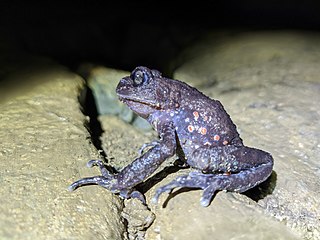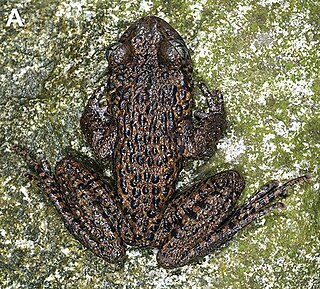Boulenophrys wuliangshanensis, commonly known as the Wuliangshan horned toad, is a species of frog found in eastern Asia. It has been found in Yunnan province in China and the state of Nagaland in India and it is thought to occur in Myanmar (Burma), although there are no records from there as yet. Its specific name refers to its type location, Mount Wuliang in Jingdong County.
Oreolalax chuanbeiensis is a species of amphibian in the family Megophryidae. It is endemic to northern Sichuan, China where it is found in Pingwu County and Mao County. Its natural habitats are temperate forests and rivers. It is threatened by habitat loss.
Oreolalax granulosus is a species of amphibian in the family Megophryidae. Being restricted to the vicinity of its type locality in Jingdong County in southern Yunnan, where it occurs in Ailaoshan National Nature Reserve. It is endemic to China. Its natural habitats are subtropical moist montane forests and rivers. It is threatened by habitat loss.
Oreolalax lichuanensis is a species of amphibian in the family Megophryidae. It is endemic to China, and found in south-central parts of the country . Its natural habitats are subtropical or tropical moist montane forests, subtropical or tropical moist shrubland, and rivers. It is threatened by habitat loss.
Oreolalax major is a species of amphibian in the family Megophryidae. It is endemic to China and found in Sichuan and Yunnan provinces, between Mount Emei and Hengduan Mountains. It likely exists in Emeishan, Wawushan, Gonggashan, Wolong, and Dujiangyan National Nature Reserves. Its natural habitats are subtropical moist montane forests and rivers. It is threatened by habitat loss.
Oreolalax multipunctatus is a species of amphibian in the family Megophryidae. It is endemic to the Mount Emei region in Emeishan and Hongya counties of Sichuan, China. Its natural habitats are subtropical moist montane forests and rivers. It is threatened by habitat loss.
Oreolalax nanjiangensis is a species of amphibian in the family Megophryidae. It is endemic to China. It is known from the area of the type locality of Mount Guangwu (光雾山), Nanjiang County, northern Sichuan, as well as adjacent southern Gansu and southwestern Shaanxi. Its natural habitats are temperate forests and rivers. It is threatened by habitat loss associated with tourism.
Oreolalax omeimontis is a species of amphibian in the family Megophryidae. It is endemic to Sichuan, China where it is found in Mount Emei and in Hongya County. Its natural habitats are subtropical moist montane forests and rivers. It is threatened by habitat loss.
Oreolalax pingii is a species of amphibian in the family Megophryidae. It is endemic to south-western China where it is restricted to the Daliang and Hengduan Mountains in Sichuan and Yunnan. Its natural habitats are subtropical moist montane forests, moist shrubland, and rivers. It is threatened by habitat loss.
Oreolalax popei is a species of amphibian in the family Megophryidae. It is endemic to China where it is found in southern Gansu, southern Shaanxi, and central and northeastern Sichuan provinces. Its natural habitats are temperate forests, subtropical moist lowland forests, moist montane forests, and rivers. It is threatened by habitat loss.
Oreolalax puxiongensis is a species of amphibian in the family Megophryidae. It is endemic to China where it is only known from two locations in Yuexi County, Sichuan, including Puxiong (普雄镇), its type locality. It inhabits marshes, pools, small streams and the surrounding subtropical forest. It is threatened by habitat loss.

Oreolalax rhodostigmatus is a species of amphibian in the family Megophryidae. It is endemic to central and south-central China where it can be found in Hubei, Sichuan, Guizhou, and Hunan provinces. While its distribution is relatively wide, it is known from only few locations. Its natural habitats are limestone caves in forested habitats. Breeding takes place in springs and stream pools inside the limestone caves. It is threatened by habitat loss and locally by collection for food (tadpoles).
Oreolalax rugosus is a species of amphibian in the family Megophryidae. It is endemic to China where it can be found in the Hengduan Mountains in southern Sichuan and northern Yunnan provinces. Its natural habitats are subtropical moist montane forests and rivers. It is threatened by habitat loss.
Oreolalax schmidti is a species of amphibian in the family Megophryidae. It is endemic to China where it can be found in the Hengduan Mountains in western Sichuan and northern Yunnan provinces. Its natural habitats are temperate forests, subtropical moist shrubland, rivers, swamps, and freshwater marshes. It is threatened by habitat loss. It is named after Karl Patterson Schmidt, American herpetologist.
Oreolalax weigoldi, also known as Weigold's lazy toad or Weigold's toothed toad, is a species of amphibian in the family Megophryidae. It is endemic to Sichuan, China. It is only known from its type locality, Washan in southern Sichuan; there are, however, many places with this name in Sichuan. It might be the same species as Oreolalax major(Liu and Hu, 1960).
Oreolalax xiangchengensis is a species of amphibian in the family Megophryidae. It is endemic to China where it can be found in western Sichuan and in the Hengduan Mountains in northern Yunnan. Its range includes Baimaxueshan, Habaxueshan, Panzhihua-Sutie, and Yading Nature Reserves.
The Jingdong horned toad, or Jingdong spadefoot toad, is a species of frog in the family Megophryidae found in Yunnan and Guangxi, China. It is expected to also occur in northern Vietnam. Its natural habitats are subtropical or tropical moist montane forests and rivers. It is threatened by habitat loss.
Odorrana jingdongensis is a species of frogs in the family Ranidae. It is known from southern China and northern Vietnam, though it quite likely also occurs in the adjacent areas in Laos and in Myanmar. Its name refers to its type locality, Jingdong Yi Autonomous County in Yunnan. Common name Jingdong frog has been coined for it.

Oreolalax longmenmontis is a species of frog in the family Megophryidae. It is endemic to Sichuan, China, and is only known from its type locality in the White River National Nature Reserve, Pengzhou City. The type locality is in the central part of the Longmen Mountains. Accordingly, common name Longmen Mountains toothed toad has been proposed for this species.


